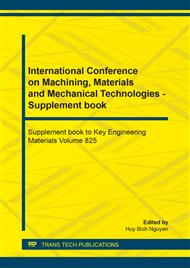[1]
J. Nohava, N.X. Randall, N. Conté, Novel ultra nanoindentation method with extremely low thermal drift: Principle and experimental results,, J. Mater. Res., Vol. 24, No. 3, Mar (2009).
DOI: 10.1557/jmr.2009.0114
Google Scholar
[2]
Z. Hu, Kevin J. Lynne, Sai P. Markondapatnaikuni, F. Delfanian, Material elastic-plastic property characterization by nanoindentation testing coupled with computer modeling,, Mater Sci Eng A 2013; 587: 268–282.
DOI: 10.1016/j.msea.2013.08.071
Google Scholar
[3]
S.P. Wadikhaye, Y.K. Yong, S.O.R. Moheimani, Design of a compact serial-kinematic scanner for high-speed atomic force microscopy: an analytical approach,, IET Micro Nano Lett. 7 (4) (2012) 309–313.
DOI: 10.1049/mnl.2011.0477
Google Scholar
[4]
A.S. Putra, S. Huang, K.K. Tan, S.K. Panda, T.H. Lee, Design, modeling, and control of piezoelectric actuators for intracytoplasmic sperm injection,, IEEE Trans. Control Syst. Technol. 15 (5) (2007) 879–890.
DOI: 10.1109/tcst.2007.902950
Google Scholar
[5]
H. Kim, J. Kim, D. Ahn, D. Gweon, Development of a nanoprecision 3-DOF vertical positioning system with a flexure hinge,, IEEE Trans. Nanotechnol. 12 (2) (2013) 234–245.
DOI: 10.1109/tnano.2013.2242088
Google Scholar
[6]
M. Ling, J. Cao, M. Zeng, Jing Lin and Daniel J Inman, Enhanced mathematical modeling of the displacement amplification ratio for piezoelectric compliant mechanisms,, Smart Mater. Struct. 25 (2016) 075022-11.
DOI: 10.1088/0964-1726/25/7/075022
Google Scholar
[7]
T.P. Dao, et al., Analysis and optimization of a micro-displacement sensor for compliant microgripper,, Microsystem Technologies. 23.12 (2017) 5375-5395.
DOI: 10.1007/s00542-017-3378-9
Google Scholar
[8]
T.P. Dao and S.C. Huang, Design and multi-objective optimization for a broad self-amplified 2-DOF monolithic mechanism,, Sādhanā. 42 (2017) 1527-1542.
DOI: 10.1007/s12046-017-0714-9
Google Scholar
[9]
L.J. Lai, Z.N. Zhu, Design, Modeling and testing of a novel flexure-based displacement amplification mechanism,, Sensors and Actuators A: Physical. 266 (2017) 122-129.
DOI: 10.1016/j.sna.2017.09.010
Google Scholar
[10]
Q. Xu, Design of a Large-range compliant rotary micropositioning stage with angle and torque sensing,, IEEE Sensors. 15.4 (2015) 2419-2430.
DOI: 10.1109/jsen.2014.2377779
Google Scholar
[11]
H. Kim, D. Ahn, and D. Gweon, Development 3-degrees of freedom flexure based positioning system,, Rev. Sci. Instrum 83, 055114 (2012).
DOI: 10.1063/1.4720410
Google Scholar
[12]
K. Lu, J. Zhang, W. Chen, J. Jiang, and W. Chen, A monolithic microgripper with high efficiency and high accuracy for optical fiber assembly,, Proc. 2014 9th IEEE Conf. Ind. Electron. Appl. ICIEA 2014, p.1942–1947, (2014).
DOI: 10.1109/iciea.2014.6931486
Google Scholar
[13]
Y. Yang, Y. Wei, J. Lou, and F. Xie, Development and precision position / force control of a new flexure-based microgripper, J. Micromechanics Microengineering,, vol. 26, p.15005, (2016).
DOI: 10.1088/0960-1317/26/1/015005
Google Scholar
[14]
Q. Xu, Design and testing of a novel multi-stroke micropositioning system with variable resolutions,, Review of scientific instruments, Rev. Sci. Instrum. 85, 025002, (2014).
DOI: 10.1063/1.4866475
Google Scholar
[15]
P. Wang, Q. Xu, Design of a flexure-based constant-force XY precision positioning stage,, Mechanism and Machine Theory. 108 (2017) 1-13.
DOI: 10.1016/j.mechmachtheory.2016.10.007
Google Scholar
[16]
T.H. Hou, C.H. Su, W.L. Liu, Parameters optimization of a nano-particle wet milling process using the Taguchi method, response surface method and genetic algorithm,, Powder Technology. 173 (2007) 153-162.
DOI: 10.1016/j.powtec.2006.11.019
Google Scholar
[17]
T.P. Dao, S.C. Huang, P. T. Thang, Hybrid Taguchi-cuckoo search algorithm for optimization of a compliant focus positioning platform,, Applied Soft Computing. 57 (2017): 526-538.
DOI: 10.1016/j.asoc.2017.04.038
Google Scholar
[18]
S.C. Huang, T.P. Dao, Multi-objective optimal design of a 2-dof flexure-based mechanism using hybrid approach of grey-taguchi coupled response surface methodology and entropy measurement,, Arabian Journal for Science & Engineering. 41.12 (2016) 5215-5231.
DOI: 10.1007/s13369-016-2242-z
Google Scholar


